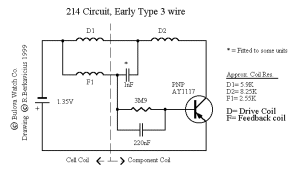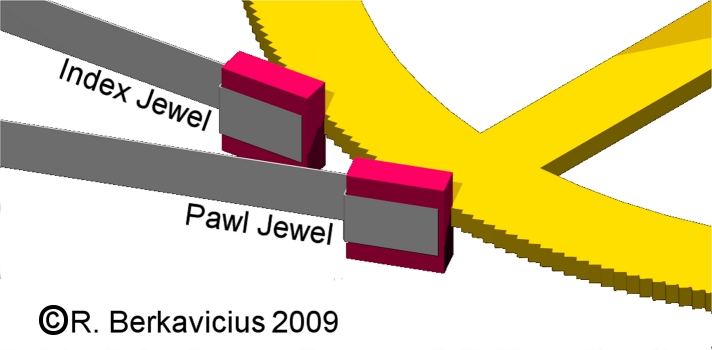
Like conventional watches which have a spring and a balance wheel, Bulova Accutrons have a train of gear wheels to drive the hands. And that is basically where the similarity ends. In an Accutron, the spring equates to the battery, and the balance equates to the tuning fork. So, it is these two areas which are of interest to Accutron enthusiasts. One is the electronics-tuning fork combination, and the other is the index mechanism.
The Electronics
While it is relatively simple, it is neverthless interesting how the electronics driving the Accutron works. The electronic circuit combined with the tuning fork forms a a servo system . Each of the iron cups of the tuning fork has a little magnet inside it, surrounded by a coil. The fork provides the resonant or tuned part of the circuit while the electronics provides a sustaining circuit and feedback control from the fork, which is created by induction by the fork into the feedback coil.
Power from the battery flows through the transistor, and then through both of the driving coils. One of the coils (the one which is attached to the plate holding the transistor and its components) also has a secondary coil built into it. When the fork springs one way, this secondary coil provides a feedback voltage which causes the transistor to almost stop the flow of current in the driving coils, and stop driving the fork. When the fork springs back the other way, this feedback coil generates a "reverse" voltage, which causes the transistor to allow current to flow in the driving coils again. The fluctuating current in the driving coils produces a varying magnetic field, which alternately attracts and repels the tuning fork magnets. Thus it keeps on vibrating. The system is self-regulating. If the watch receives a jolt which adds to the fork vibration, the circuit automatically reduces power to the fork until it reaches the normal amplitude of vibration. The reverse is also true. While I said it is simple, it took quite a lot of work to develop the electronics to vibrate the tuning fork at the right amplitude, and yet work at such a low current that a battery would last at least a year.

One of the more interesting features of the electronics are the coils themselves. Each Accutron coil has 8,100 turns of insulated copper wire of 0.015mm diameter (or about 1/2000th of an inch). That equates to about 80 meters (or nearly 90 yards) per coil. The wire is about one-third the thickness of a human hair. Bulova manufacfured their own wire in-house, no mean feat in itself.
This mechanism, consisting of the index wheel and operating fingers, provides the means for converting the vibrations of the tuning fork into rotary motion. Even today, it is considered a truly remarkable engineering accomplishment. Though the dimensions of the working parts are incredibly small, the operation of the index mechanism is elegantly simple, and its robustness and reliability legendary. Neverthless, it is very delicate and requires special handling techniques during servicing and adjustment. The index wheel can be destroyed by simply touching it on its rim. It must be handled by its pinion only.
The part of the index mechanism that turns the index wheel consists of two very fine flat springs (or "fingers"), each fitted with a small ruby jewel cemented with epoxy onto one end. One of the springs (the pawl finger) is attached to the body of the watch by a small movable carrier and post. The other (the index finger) is attached to a post mounted on one arm of the tuning fork. The jewels of each finger rest on a special ratchet wheel (the index wheel) which has very small ratchet shaped teeth. These perfectly formed teeth are so small, they cannot be seen without the aid of a microscope.The positions of the index and pawl jewels relative to each other is adjusted by moving the pawl jewel carrier. Correct adjustment is necessary to allow for variations in fork amplitude during the life of the battery. This is known as "phasing" the index mechanism, and requires good watchmaking skills, experience on Accutrons, and a good understanding of the operation of the index mechanism to be carried out correctly.
In operation, when the fork and index jewel moves towards the index wheel, the index jewel pushes the wheel around one and a half teeth. As the fork moves back, the index wheel moves in reverse slightly and locks on the pawl jewel. The pic below shows the pawl jewel locked, and the index jewel travelling half-way back to picking up the next tooh. This occurs once for every vibration of the fork, or 360 times a second for a 214 or 218 Accutron movement. If you would like to see a more involved diagrammatic description of the mechanism, click here. The drawing below should help in visualizing the action.

The index wheel of a 218 movement is 2.40mm (0.095") in diameter and has 320 teeth, each of which is about 0.01mm high (0.0004") and 0.02mm (0.0008") wide. The index and pawl jewels are perfect little square blocks of synthetic ruby, 0.18mm (0.007") square and 0.06mm (0.002) thick. How these parts were manufactured has remained a closely-guarded secret. It is also very sad that the highly-skilled man who made all the index and pawl jewels comitted suicide, but for what reason, I do not know.
Back